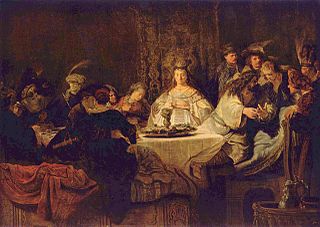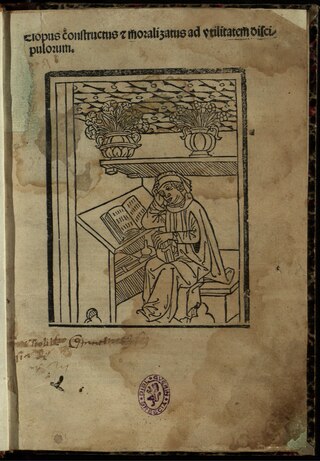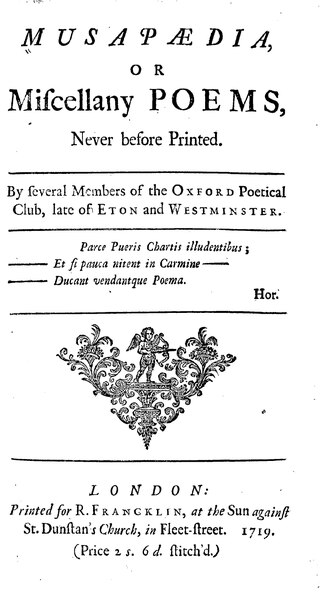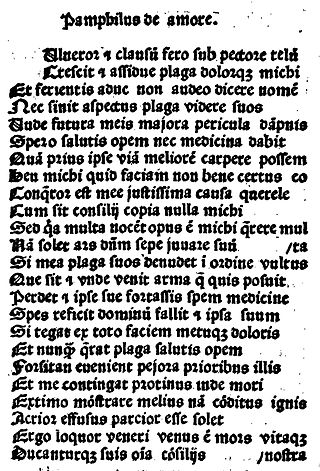Bibliography
- Traugott Lawler, The Parisiana Poetria of John of Garland. New Haven: Yale University Press, 1974.
- Traugott Lawler, Parisiana poetria. Dumbarton Oaks Medieval Library 65. Cambridge, MA: Harvard University Press, 2020.
Parisiana poetria is a work by the medieval English grammarian Johannes de Garlandia or John of Garland. Written about 1240, it is a textbook of the writing of Latin prose, classical verse and medieval (rhythmical) verse, aimed at his students at the University of Paris.

In Celtic cultures, a bard is a professional story teller, verse-maker, music composer, oral historian and genealogist, employed by a patron to commemorate one or more of the patron's ancestors and to praise the patron's own activities.

Modern lyric poetry is a formal type of poetry which expresses personal emotions or feelings, typically spoken in the first person.

John II of Castile was King of Castile and León from 1406 to 1454. He succeeded his older sister, Maria of Castile, Queen of Aragon, as Prince of Asturias in 1405.

A riddle is a statement, question or phrase having a double or veiled meaning, put forth as a puzzle to be solved. Riddles are of two types: enigmas, which are problems generally expressed in metaphorical or allegorical language that require ingenuity and careful thinking for their solution, and conundra, which are questions relying for their effects on punning in either the question or the answer.
A lai is a lyrical, narrative poem written in octosyllabic couplets that often deals with tales of adventure and romance. Lais were mainly composed in France and Germany, during the 13th and 14th centuries. The English term lay is a 13th-century loan from Old French lai. The origin of the French term itself is unclear; perhaps it is itself a loan from German Leich (reflected in archaic or dialectal English lake, "sport, play" and in modern Swedish. The terms note, nota and notula appear to have been synonyms for lai.
The Dialogue on Translation between a Lord and a Clerk, or Dialogus inter dominum et clericum, was written by John Trevisa. Along with the dedicatory Epistle, it forms the introduction to his 1387 translation of the Polychronicon of Ranulf Higden, commissioned by Trevisa's patron, Lord Berkeley. Written in Middle English, it consists of a series of arguments made by the clerk on why books should not be translated from learned languages such as Latin, each one followed by a rebuttal from the lord. The clerk eventually agrees, and the exchange concludes with a prayer for guidance in the translation.

Byzantine romance represents a revival of the ancient Greek romance of Roman times. Works in this category were written by Byzantine Greeks of the Eastern Roman Empire during the 12th century.
Geoffrey of Vinsauf is a representative of the early medieval grammarian movement, termed preceptive grammar for its interest in teaching the ars poetica.
Traugott Francis Lawler is an American medievalist. He is an authority on English poet William Langland and Medieval English. Lawler is a professor emeritus of English at Yale University, where he served as the master of Ezra Stiles College and also as a lecturer in religion and literature.

Johannes de Garlandia or John of Garland was a medieval grammarian and university teacher. His dates of birth and death are unknown, but he probably lived from about 1190 to about 1270.
Garland Science was a publishing group that specialized in developing textbooks in a wide range of life sciences subjects, including cell and molecular biology, immunology, protein chemistry, genetics, and bioinformatics. It was a subsidiary of the Taylor & Francis Group.

Gualterus Anglicus was an Anglo-Norman poet and scribe who produced a seminal version of Aesop's Fables around the year 1175.

A legendary creature is a type of fantasy entity, typically a hybrid, that has not been proven and that is described in folklore, but may be featured in historical accounts before modernity.

Spruchdichtung or Sangspruchdichtung is the German term for a genre of Middle High German sung verse. An individual work in this genre is called a Spruch, literally a "saying", and may consist of one or more strophes.

A miscellany is a collection of various pieces of writing by different authors. Meaning a mixture, medley, or assortment, a miscellany can include pieces on many subjects and in a variety of different forms. In contrast to anthologies, whose aim is to give a selective and canonical view of literature, miscellanies were produced for the entertainment of a contemporary audience and so instead emphasise collectiveness and popularity. Laura Mandell and Rita Raley state:
This last distinction is quite often visible in the basic categorical differences between anthologies on the one hand, and all other types of collections on the other, for it is in the one that we read poems of excellence, the "best of English poetry," and it is in the other that we read poems of interest. Out of the differences between a principle of selection and a principle of collection, then, comes a difference in aesthetic value, which is precisely what is at issue in the debates over the "proper" material for inclusion into the canon.
Gervase of Melkley or Gervase of Melkeley was an Anglo-Norman scholar and poet.

Pamphilus de amore is a 780-line, 12th-century Latin comedic play, probably composed in France, but possibly Spain. It was "one of the most influential and important of the many pseudo-Ovidian productions concerning the 'arts of Love'" in medieval Europe, and "the most famous and influential of the medieval elegiac comedies, especially in Spain". The protagonists are Pamphilus and Galatea, with Pamphilus seeking to woo her through a procuress.
Bergbúa þáttr is a short medieval Icelandic tale (þáttr). It tells of Þórðr and his companion who get lost on their way to church one winter and take refuge in a cave. Once inside, after they have settled down for the evening, they hear noises from the back of the cave. Later they see two huge eyes and hear a voice which recites a poem of twelve stanzas, now known as Hallmundarkviða. The speaker of these verses refers to himself as a giant, and repeats the poem three time across the course of the night. The giant instructs the humans to remember the poem or suffer a forfeit. Þórðr memorises the poem but his companion does not and subsequently dies the following year.
Kumlbúa þáttr is a short medieval Icelandic tale (þáttr) set at the end of the twelfth century or the beginning of the thirteenth. It tells the story of Þorsteinn Þorvarðsson who stumbles upon a burial cairn and takes a sword from it. After he returns home he goes to bed and is visited in a dream by the cairn-dweller. The man, who wields a huge pole-axe, demands the return of the sword and threatens Þorsteinn. Þorsteinn's wife wakes him to ask why he is sleeping so poorly but he does not tell her and goes back to sleep at once. The cairn-dweller reappears and declaims a threatening verse. However, Þorsteinn retorts with a more technically proficient verse which 'caps' that of the cairn-dweller who then leaves Þorsteinn. The following day Þorsteinn goes to look for the cairn but cannot find it. He returns home and tells his wife and other people the story.

Ulrich von Gutenburg was an Alsatian nobleman and Middle High German poet. He can be traced at the court of Emperors Frederick Barbarossa and Henry VI between 1172 and about 1200. The main influence on his poetry was Friedrich von Hausen, whom he may have known personally. His style is highly formal and he is represented in the chansonniers by a lyric poem of six stanzas in the Minnesang tradition and a similarly themed long poem of 350 verses.